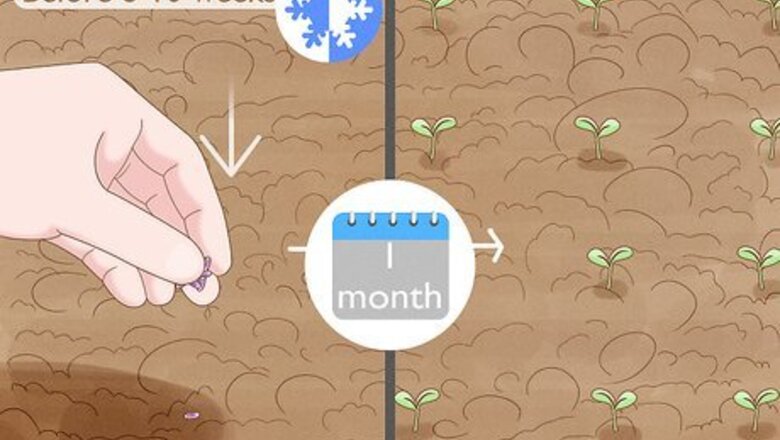
views
- Fill a seed starter tray with seed starter potting mix and place a lavender seed on top of the soil in each tray cell. Then, cover the seeds with a light layer of soil.
- Mist the seeds with water and place the tray in a warm, sunny spot that stays around 70° F (21° C). After about 1 month, move the sprouted seeds to direct sun.
- Plant the seedlings in 4-inch (10-cm) pots filled with well-draining soil once they have about 4-6 leaves.
Germinating Lavender Seeds
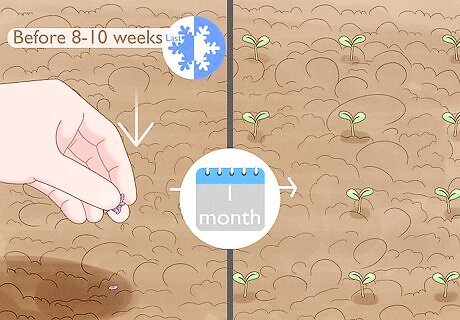
Start the seeds 8 to 10 weeks before your area’s last frost date. Lavender seeds germinate slowly, often taking at least 1 month to fully sprout. So, start germinating them 8 to 10 weeks before you get warm weather, which is often the last day of frost for your area. This lets you plant the lavender as soon as it sprouts, and gives your lavender plenty of time to grow into mature plants during the warm growing season. Lavender comes in several different varieties, such as English, Spanish, and French lavender. English lavender tends to be the most popular lavender variety to grow. The last frost date is the last day in spring when your area typically experiences freezing weather. Search for your area’s last frost date online, or check out this interactive map if you live in the US.
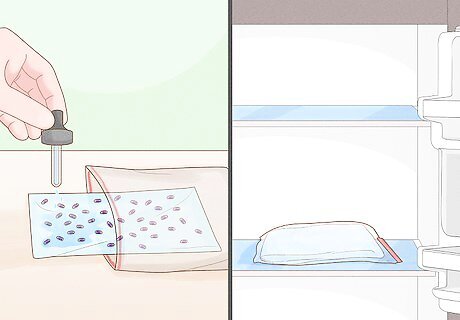
Place harvested seeds between damp paper towels in the fridge for 3 weeks. Lavender seeds go through a process called cold stratification, where they stay in cold temperatures to promote germination. If you harvested your own seeds, put them through this process yourself! Just dampen 2 paper towels and drop the seeds in between them. Seal the seeds and paper towels in a plastic bag, then store them in your fridge for about 3 weeks. Most lavender seeds you buy in seed packs have already gone through cold stratification. Only stratify your seeds if you harvested them yourself from another plant.
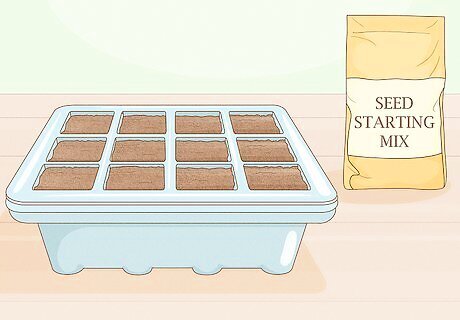
Fill a seed starter tray with seed starting mix. Prepare your seeds for germination by choosing a well-draining seed starting mix. Just pour the soil into a multi-cell starter tray, or into a wide, shallow container without divisions. Lavender seeds germinate the best when they’re kept indoors. While you can sow the seeds directly into your garden, creating a controlled environment inside typically produces more successful sprouts in a shorter amount of time.
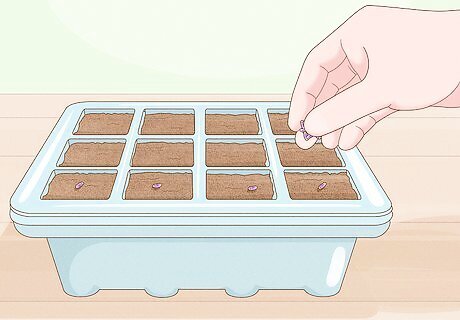
Drop the seeds on top of the soil. Lavender seeds need light to germinate and sprout. If you cold stratified your seeds in the fridge, carefully pick them up off the paper towel. Then, simply sprinkle the seeds on top of the soil. If you’re planting the seeds in a multi-cell starter tray, plant one seed per cell. If you’re planting in a division-free container, space the seeds ½ to 1 inch (1-2 cm) apart.
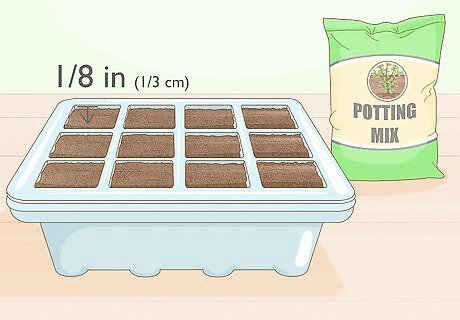
Cover the seeds with ⅛ inch (⅓ cm) of the seed starter mix. Sprinkle a light layer of the potting mix over the seeds. Make sure it isn’t more than ⅛ inch (⅓ cm), as light still needs to reach the seeds.
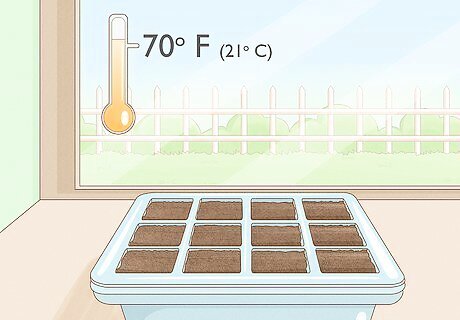
Set the seeds in a warm spot indoors that stays around 70° F (21° C). Lavender seeds sprout the best when they’re kept around 70° F (21° C), so find a warm, sunny spot for them to rest. If you don’t have an area in your home that stays consistently warm, place a heat mat underneath the seeds.
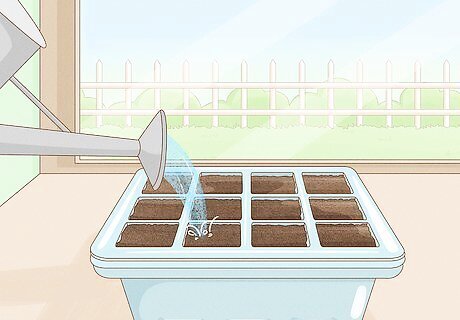
Lightly water the seeds so the soil is moist. Use a spray bottle to lightly mist the soil, making sure it is damp but not overly wet. Soil that is too damp and cool can invite fungus to grow, which can harm your seeds.
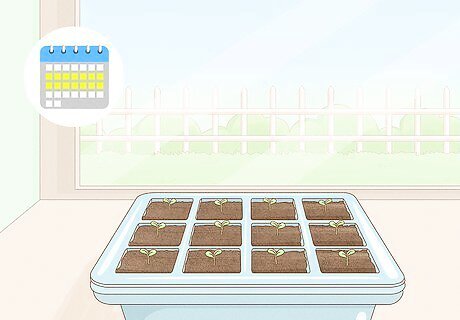
Monitor your seeds’ growth and the soil moisture over the next month. Lavender seeds typically take between 2 weeks to 1 month to sprout, though they sometimes take even longer. Make sure the soil stays moist by pressing your finger into the potting mix. If it feels dry, give the soil a misting of water. Growing lavender from seeds can be tricky, so don’t be discouraged if only a few lavender seeds sprout, or none germinate at all. Just grab some more seeds and start germinating again.
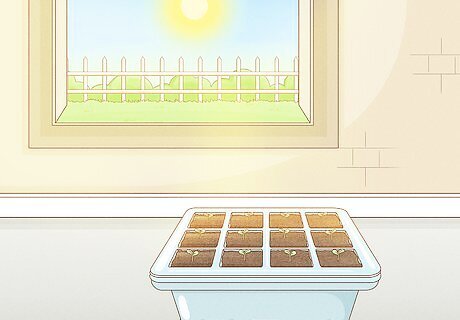
Move the seedlings to a spot that gets direct light once they sprout. Lavender needs a lot of light to grow, so find a bright, sunny spot once the seeds sprout out of the dirt. If you don’t have a spot that gets direct light, place a grow light over the seedlings, keeping it on for about 6 to 8 hours each day.
Transplanting Lavender
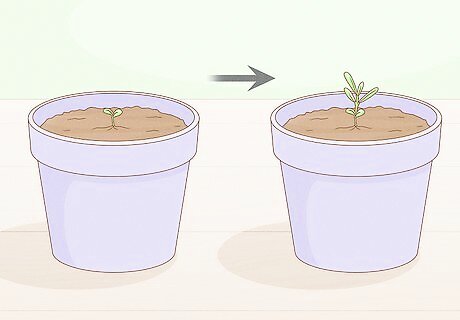
Move the seedlings to pots when they grow 4 to 6 true leaves. True leaves are the leaves that grow after the 2 round seed leaves that sprout with the plant. Growing 4 to 6 true leaves signifies that the seedlings are mature and their root systems are too large to keep in their starting container.
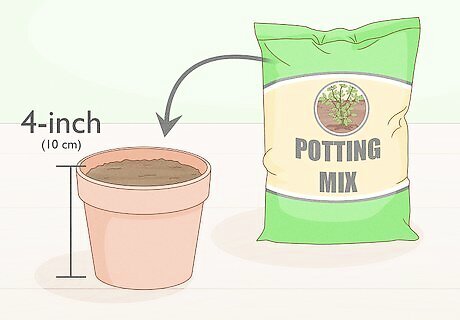
Fill a 4-inch (10 cm) pot with well-draining potting mix. Lavender is a drought-tolerant plant, which means that it doesn’t like to stay in wet soil. Choose a well-draining potting mix that is slightly sandy or gravelly or part soil, part peat, and part perlite. Then, pour the soil into 4-inch (10 cm) pots that have drainage holes. If you mix your own soil, combine regular, well-draining potting mix with a sandy potting mix for succulents or cactuses in a 1:1 ratio. Alternatively, use a larger pot or division-free tray and space multiple lavender plants in the tray 2 inches (5 cm) apart from one another. Peat moss is a non-renewable resource, so it's best to use coir dust instead, if possible. Do not use vermiculite, which may contain asbestos, even when the label doesn't say so.
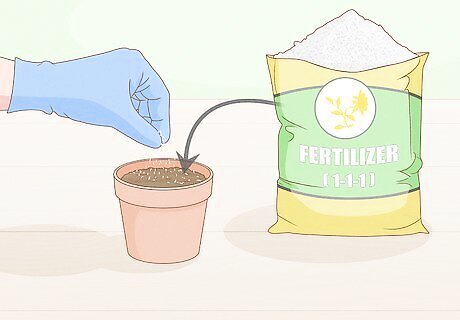
Mix a handful of slow-release fertilizer into the soil. Place a small amount of granular slow-release fertilizer into each pot and mix it well with the soil. Choose a fertilizer that contains a balanced 1:1:1 proportion of nitrogen, phosphorus, and potassium. If your potting mix already contains fertilizer, skip adding more fertilizer to your pots. Lavender doesn’t need much fertilization to grow well, so too much can harm your plants.
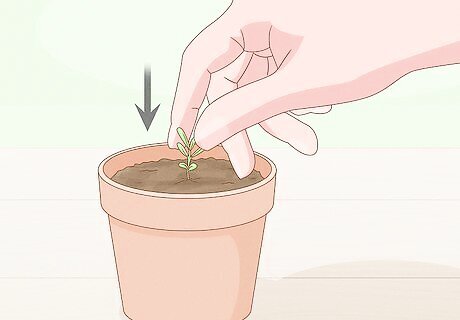
Plant the lavender into the prepared pot. Dig a small hole in the potting soil that is about as big as the container the lavender is currently in. Loosen the soil around the lavender by pressing a small shovel or butter knife around the edge of the container. Then, gently scoop it out. Place it into the hole in the new pot, packing the soil around it to keep it firmly fixed in place. Then, water your plant thoroughly.
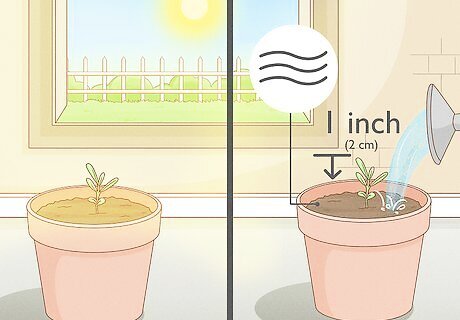
Give the potted lavender 6 to 8 hours of light and keep the soil moist. Choose a spot for your newly potted lavender plant that gets lots of bright, direct light. If you don’t have a sunny area indoors, place a grow light over the lavender. Then, water your plant when the top 1 inch (2 cm) of soil feels dry to the touch. Keep your lavender inside as an indoor plant if you don’t want to plant it outside. Just make sure to repot your plant in a container 1 to 2 inches (2-5 cm) larger than its current one when its roots grow visible at the top or bottom of its pot.

Let the lavender grow to about 3 inches (7.6 cm) before planting outdoors. Your tiny lavender plants need to grow established root systems before you transplant them outdoors in your garden. Just wait until they’re about 3 inches (7.6 cm) tall, which often takes 1 to 3 months.
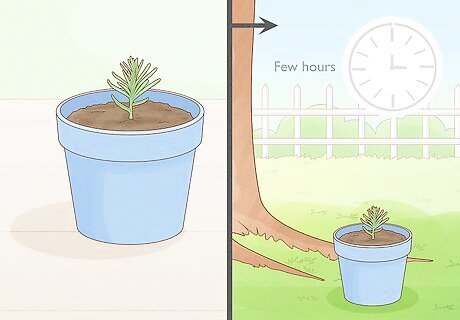
Expose the lavender to outdoor conditions over the course of 1 week. Immediately planting your lavender outside can damage it because it’s not used to the outdoors. So, place your pots outside in partial shade or partial sun for a few hours at a time, increasing their time outdoors a little each day. Do this for about 1 week, which is long enough for the lavender to adapt to outdoor conditions and direct sunlight. This process of acclimating your plant to the outdoors is called "hardening off."
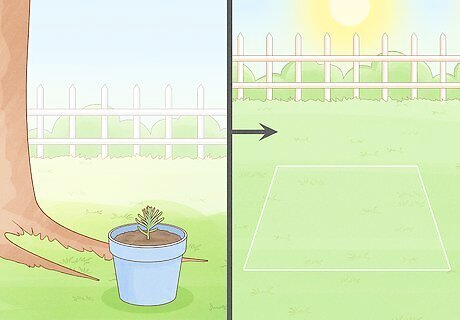
Find a location outside that gets direct light and has well-draining soil. Lavender plants grow best when they get 6 to 8 hours of full, direct sun each day. Shaded areas tend to be soggier, and soggy soil can invite fungi that harm the plant. Make sure the spot you choose doesn’t collect standing water, as lavender does best in soil that drains quickly.
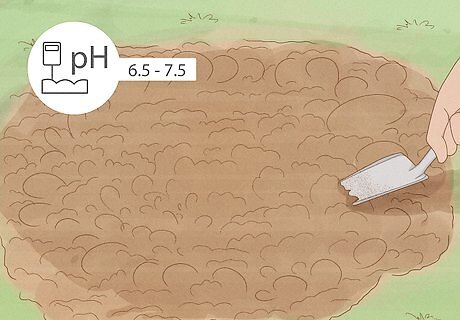
Loosen the garden soil with a trowel and mix in compost. This helps aerate your soil, which improves the air circulation around your plants. Chop the soil up with a trowel or a digging fork to loosen it. Then, mix in about 1 inch (2 cm) of compost. Compost has uneven particles, creating looser soil and making it easier for the lavender’s roots to stretch out. The loose soil also helps water to drain faster. Check the soil pH after adding compost with a pH test strip. Lavender grows best in soils between 6.5 and 7.5 pH. If your soil pH is too low, mix in a handful of agricultural lime. If it is too high, add a small amount of plant litter or pine sawdust. Plant your lavender on mounds if your area has a damp winter or spring. Create dirt mounds that are about 18 to 24 inches (46-61) tall. When you dig out the hole inside the mound, mix gravel into the soil at the bottom to help improve water drainage.
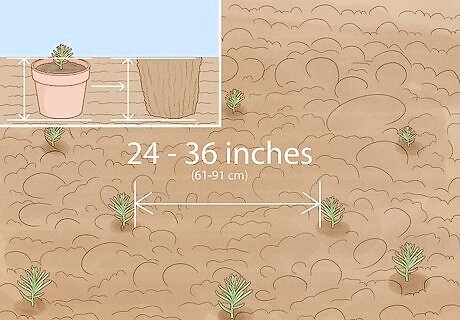
Plant the lavender plants about 24 to 36 inches (61-91 cm) apart. Dig a hole that is as deep as the container the plant is currently in. Remove the plant from its pot by using a garden trowel to carefully slide it out. Set the lavender into its new hole and pack soil around it to fill it in. Dig another hole about 24 to 36 inches (61-91 cm) away and set the next plant inside. When you’re done planting, water each lavender plant thoroughly. Most lavender varieties grow between 1 to 3 feet (30-91 cm) tall and wide. They need good air circulation to grow well, so spacing them far apart ensures their success in your garden.
Caring for and Harvesting Lavender
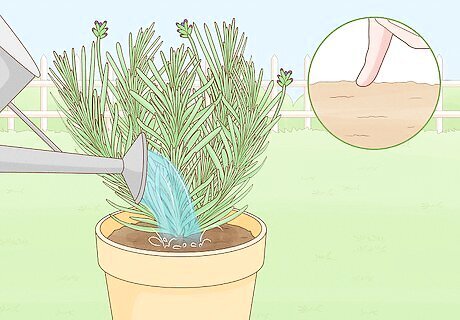
Water the lavender when its soil is dry. Mature lavender is fairly drought-resistant, but it needs regular waterings during its first year of growth. Give your lavender a good soak about once or twice a week. Just allow the soil to dry out in between watering, checking if it’s dry by sticking your finger 1 to 2 inches (2-5 cm) deep into the soil. As your lavender matures in its second year of growth, cut back to watering it every 2 to 3 weeks. When it starts growing flowers, move back to watering it every 1 to 2 weeks.
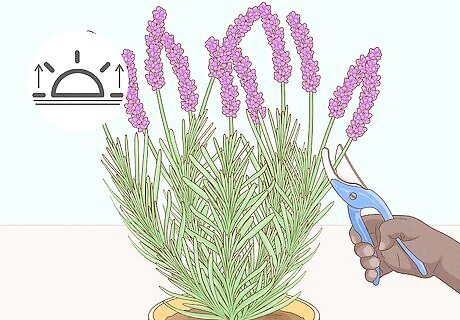
Harvest lavender flowers when they’re fully open and vivid. The best part about growing lavender is cutting off and enjoying its beautiful blooms. Just wait until the flowers are completely open. Then, snip the flowering stems off with scissors or cutting shears in the morning, which helps preserve the sweet-smelling oils in the flowers. If you want to dry out your lavender, cut off several blooming stems and tie them together in a bunch. Then, hang them upside down in a dark, dry place for about 1 to 2 weeks. When they’re dry, use them in your cooking, make soap, or craft DIY potpourri. To store dried lavender, seal the flowers in dark, plastic containers and place them in a cool, dark, and dry area.
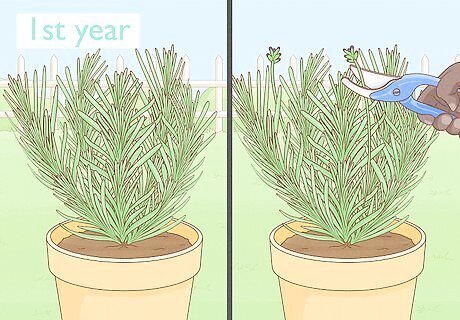
Prune lavender after it flowers each year. Pruning lavender encourages more flowering, so snip off the top ⅓ of its stems after it finishes producing flowers at the end of the summer. Lavender grows slowly during the first year, as most of the plant's energy goes toward root and vegetative growth. Your plant might flower slightly in its first year, but by its 2nd or 3rd year of growth, it’ll reach its full blooming potential. Even if your lavender does not bloom in its first year, still prune back ⅓ of its new growth. This encourages more stem growth and flowers when it blooms next year. Do not cut into stems that are hard and woody. When you cut into lavender’s woody base, those stems typically don’t grow back.
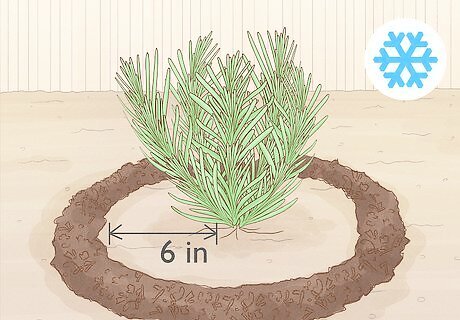
Place gravel mulch around the lavender when the weather gets cold. When you plant lavender outside, keep the soil warm by applying gravel or rock mulch around the base of the plant. Just leave about 6 inches (15 cm) of free space around the stem to promote air circulation.
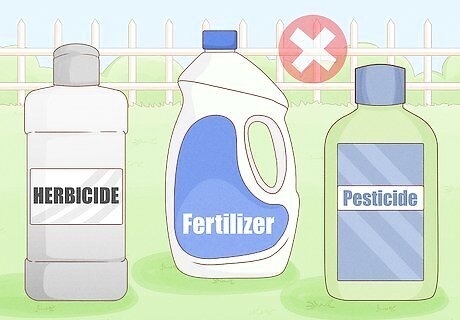
Avoid using chemicals around your lavender plants. Herbicides, pesticides, and even some fertilizers can kill the beneficial organisms that live in the garden soil and help your lavender thrive. Skip adding more fertilizer once you plant the lavender in the ground. If you are treating the lavender for pests, use an organic pesticide solution that contains no chemicals. Lavender is not very susceptible to pests, though in some cases they can get infected by spittlebugs. These bugs generally don’t harm lavender and are easy to wash away with a spray of water.



















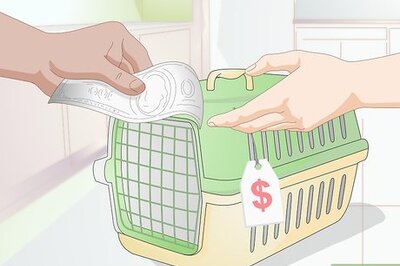
Comments
0 comment